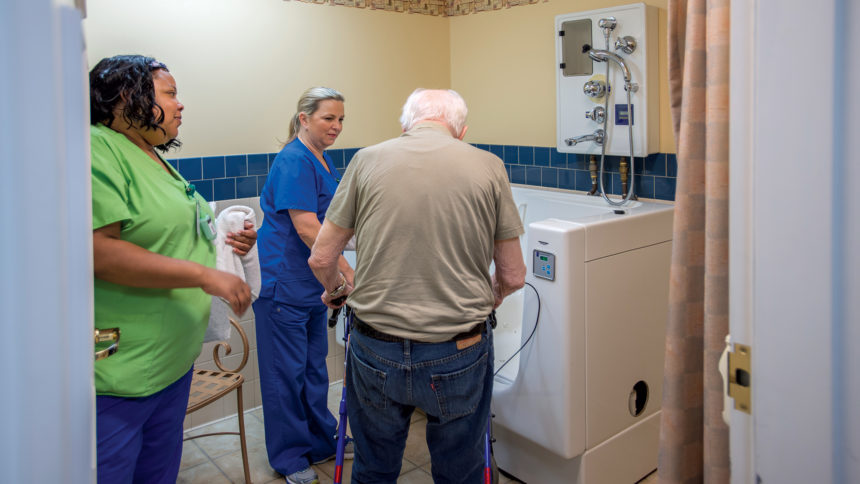
Bathing and lifts can be a source of anxiety for both residents and caregivers alike. For the resident, it can be an awkward experience being transported and mechanically lifted into a tub. For the caregiver, it’s the paramount responsibility of ensuring the resident’s safety and dignity.
With the right approach, however, procedures and bathing options, the process doesn’t have to be a stressful one, experts in the field say.
Len Sears, director of sales for ProCare Medical, says a high degree of safety has been part of the bathing procedure infrastructure in the skilled nursing sector for years and should serve as a blueprint for senior living operators.
For instance, skilled nursing facilities are required to evaluate a resident’s physical and mental ability on admission, which determines how care should be administered and which aids to daily living assistance are required. This evaluation includes risk assessments for falls and flight. As a result, there are different types of equipment specifically geared for individuals based on their abilities.
“A good analogy involves cars — different vehicles are designed for different tasks, such as pickup trucks and minivans,” Sears says. “You cannot properly maintain a car without the right tools, and different cars require different tools. The same can said for care of the elderly, as you cannot buy one lift that is appropriate for everybody. The challenge for residents is accepting the fact they need assistance, and for operators it is providing resident-centric equipment for that assistance.”
New requirements of participation in long-term care mandate a focus on the individual, and the “inevitable migration” of these rules to senior living means that operators also must provide this focus on individual need, Sears says. A major part of this focus, he adds, is handling each resident’s transition to higher acuity of care, which mitigates the stress of moving.
Resident transport is a key part of the bathing safety process, and residents always should be transported by wheelchair, says Matt Jante, product manager for healthcare equipment and textiles at Direct Supply.
“For dignity purposes, it is highly recommended that residents be moved fully clothed or in a robe,” he says. “That way, the resident can undress in privacy instead of being moved around half-clothed. This makes the whole bathing experience a much more dignified routine.”
Sears contends the situation differs based on the individual’s abilities and that senior living residents usually aren’t as dependent as those in skilled nursing. Still, he says it is a natural trait to deny the onset of physical limitations and that caregivers need to be compassionate and gently persuasive in assisting each resident.
“For safety purposes, it’s important to show that we care and have their best interests at heart, and for those reasons, we need them to work with us during their transition in life,” he says. “There is no shame in that. But allowing them to think they are still capable of living like they used to, when it’s evident they can’t, is problematic and dangerous. Hip fractures from falls are still too common and can be avoided with proper care and practice.”
Safety and comfort
The bathing suite can be fraught with dangers if routine safety checks are not made constantly, Jante says.
“Areas that need specific inspection include the floors for slip-and-fall hazards,” he adds. “Areas where water collects and does not drain are incredibly dangerous. Tubs should be cleaned and sterilized routinely based on manufacturer directions to prevent the spread of infection throughout the facility.”
Sears offers a safety checklist for the bathing suite that includes ensuring that grab bars are secure, no loose materials or debris are on the floor, installing slip-resistant strips on the floor and checking them regularly, maintaining a proper working space with a caregiver always present, ensuring the emergency call is working properly, and cleaning tubs and showers after every use.
Space utilization in the bathing suite is a key safety and comfort factor, especially for swing-out, step-in tubs, Sears says.
“Try to have the tub centered on a wall and not in a corner,” he says. “This allows the door to fully open for access. There should also be adequate space around the tub for the caregiver, for a wheelchair and for a lift, with proper doorway width for entrance to the room.”
If space is an issue, then Sears recommends a tub with a door that swings inside the tub.
“However, these tubs should only be used for residents who are ambulatory or need minimal assistance, which reduces their versatility with a diversified population,” he says.
Atmosphere and ambience are critical ingredients for creating a pleasant, comfortable bathing atmosphere and can be achieved multiple ways: soft colors in the room, plants, artwork, lighting in the water and various media.
“Media can provide soothing music through a Bluetooth or plug-in device, for example, or a TV to watch their favorite shows,” Sears says. “These features can be achieved with all types of tubs.”
Tubs versus showers
When it comes to which bathing method is most suitable, opinions are split about whether communal tubs or private showers offer the best resident experience.
Overall, the move toward a “wellness” atmosphere similar to a resort has gained strength in senior living and should become more popular in the future, Jante says.
“This evolution started with shower chairs, which now offer tilt-in-space for added comfort and is a trend we are seeing in senior living communities,” he says. “Creating an environment that not only is meant for hygiene but also for overall health improvement should continue to grow.”
Market observers see a shift away from bath tubs in a communal setting in favor of in-room private shower units.
“In the senior living market, the definitive trend is towards accessible roll-in showers in each room, accompanied by pull-down bath benches or stand-alone showering stand or chair,” Sears says. “These shower stalls are supported by properly located grab bars. Most communities have central areas for individuals wanting to immerse in water, but it should be noted the trend towards showering could be viewed as behavioral, because many people grew up taking showers. Yet others grew up taking baths, so it is still up to individual preference.”
Tubs inherently are designed to accommodate different levels of physical ability. But aesthetics also play a role — a tub designed for higher-acuity residents may have an institutional look that a senior living community is trying to avoid.
Ultimately, senior living operators need to consider the various tub models — standard, walk-in, swing-out or swing-in styles — and determine the options that fit the acuity levels and preferences of residents.
Tub manufacturer Lee Penner acknowledges the trend but maintains that bathing in a tub is a superior hygiene experience.
“Residents need more than just a shower,” he says. “In a shower, the water hits the body and runs off. It gets you somewhat clean. But in a spa tub, the cavitation of the bubbles creates a vacuum and pulls dead skin and dirt away from the body. This isn’t just a claim — it is a scientifically proven fact.”
Future of bathing
How the bathing suite evolves in the future will be determined largely by the Baby Boom generation, which has members retiring at a rate of 10,000 per day. Their preferences and influence will decide whether communal baths will continue to be a part of a community or if in-room, private bathing will become exclusive.
Penner says there is a lot of opportunity for bathing manufacturers to shape the future for the senior living industry. He reports working on a project that will take bathing “in a different direction by building a better mousetrap.” Although tight-lipped about specifics, he indicates that it will be revealed in the fall.
Sears sees various potential innovations, such as voice-activated directions to the tub, programmed preferences that include water temperature, duration of the bath, strength of water agitation and custom music playlists for residents. Even so, he says the most important innovation is ensuring that the caregiver is always present because “it negates the need for innovation.”



